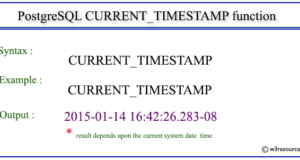
ON fpm_left.name = fpm_right.name AND fpm_left.id != fpm_right. Interval fields (p) length of time, with optional units to restrict the type. Time (p) time of day Timestamp tz (p) date and time with optional timezone. JOIN (SELECT * FROM message WHERE IN in (SELECT max(id) AS id FROM message GROUP BY name)) fpm_right What are the Available Date and Time Data types Date day of year using the Gregorian calendar. (SELECT * FROM message WHERE id IN (SELECT min(id) AS id FROM message GROUP BY name)) fpm_left My description already contains the magic words function and constant. Which does not produce the expected output SELECT fpm_left.name, age(fpm_right.timestamp_received, fpm_left.timestamp_received) Most people are not aware of the fact that there is actually a difference between now () as a function and ‘NOW’::timestamptz as a constant. What I have tried so far: SELECT name, timestamp_received - LAG(timestamp_received, 1) OVER (PARTITION BY name ORDER BY id ASC) delta

I'd like to get the delta of the timestamp per name

Note that this changes only the table in the database, not the model in the JavaScript side. With this call, Sequelize will automatically perform an SQL query to the database. A model can be synchronized with the database by calling model.sync(options), an asynchronous function (that returns a Promise). This is where model synchronization comes in. However, what if the table actually doesn't even exist in the database? What if it exists, but it has different columns, less columns, or any other difference? When you define a model, you're telling Sequelize a few things about its table in the database. After being defined, we can access our model with. We want our model to be called User, and the table it represents is called Users in the database.īoth ways to define this model are shown below. To learn with an example, we will consider that we want to create a model to represent users, which have a firstName and a lastName. Extending Model and calling init(attributes, options)Īfter a model is defined, it is available within sequelize.models by its model name.Calling fine(modelName, attributes, options).Models can be defined in two equivalent ways in Sequelize: You can combine TOCHAR () and the Now () function to convert the current timestamp into the specified format. You can specify double colons (::) to cast a DATETIME value to a DATE value.

Usually, models have singular names (such as User) while tables have pluralized names (such as Users), although this is fully configurable. Now () function The Now () function returns the current system timestamp (date and time).

This name does not have to be the same name of the table it represents in the database. The model tells Sequelize several things about the entity it represents, such as the name of the table in the database and which columns it has (and their data types).Ī model in Sequelize has a name. In Sequelize, it is a class that extends Model. A model is an abstraction that represents a table in your database. transactiontimestamp () is equivalent to CURRENTTIMESTAMP, but is named to clearly reflect what it returns.
Postgresql timestamp difference how to#
In this tutorial you will learn what models are in Sequelize and how to use them.


 0 kommentar(er)
0 kommentar(er)
